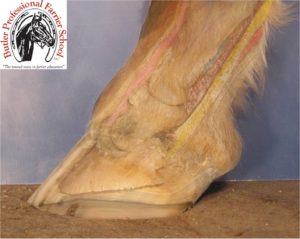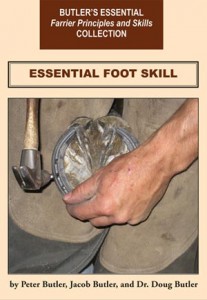Inside the Foot

A skilled farrier can “see” inside the horse’s foot in order to balance the internal anatomical structures where there will be the least amount of stress.
Trimming and shoeing a horse’s foot can be a stressful experience to the careful beginner. No one wants to intentionally harm the horse. In order to gain more confidence about trimming the hoof, a farrier must learn what is inside the foot. Just like any good mechanic understands what is under the hood of the car and how everything works, the farrier must know the anatomy inside the hoof and the function of each anatomical structure. The farrier should be able to visualize the position of the coffin bone within the foot and balance the hoof in order to keep the internal structures under the least amount of pressure.
The best way to tell the position of the Distal Phalanx, or P3, is to have a lateral/medial radiograph of the hoof. Usually, the foot will have to be placed on a block to get the x-ray beam parallel to the base of the bone.
Without an x-ray, you can look at the slope of the upper one third of the hoof wall, just below the coronet. If the wall is tightly adhered to P3, this will give you an accurate angle for the hoof wall and bone. Ideally the angle of the base of the coffin bone is 5-10˚with the ground. Ideally the angle of the dorsal front surface of P3 is parallel to the slope of the pastern.
You can also run your finger down the front of the pastern. If your finger slides easily over the coronary band, the bone is in a normal position. If your finger stops or falls into a crevice at the hair line, the bone has sunk within the hoof capsule. Another indication that the bone has sunk, is the dropping of the sole. If the sole is flat, that indicates the bone has sunk down due to a weakened or destroyed laminar attachment. This is the case in foundered feet.
The best way to understand what is inside the horse’s hoof is to study the anatomy of the equine foot. A good resource is The Principles of Horseshoeing (P3) and videos from our Essential Farrier Principles and Skills Collection. Until you have studied enough to know the foot backwards and forwards and can visualize what is located within the hoof, you should be dealing only with sound backyard horses and referring other cases needing more expertise to a qualified farrier.
It is interesting to see the students’ progress at our school. At first, some are hesitant to even begin trimming the hoof. With the sequential learning we provide at Butler Professional Farrier School, they each gain confidence until they visualize the interior of the horse’s foot.
Check out our videos on Essential Anatomy and Essential Foot Skill. These videos will help you to learn what is exactly in the foot and how to know how much to safely trim.
Related Posts
-
In the fall, as the temperatures drop, horses will get some ...Nov 17, 2016 / 0 comments
-
Happy Independence Day! This is a wonderful time of year to ...Jul 03, 2019 / 0 comments
-
In these hot summer months, it is important to consider your...Jun 28, 2018 / 0 comments
Blog Categories
- Anatomy
- Best Business Practices
- Conformation
- Current Events
- Customer Service
- Draft Horse Shoeing
- Equine Soundness
- Essential Anatomy Kit
- Farrier Careers
- Farrier training
- Foal soundness
- Horse Care
- Horse Foot Care
- Horse Owner Tips
- Horsemanship
- Horseshoeing
- Horseshoeing History
- Iron and Forge Work
- Student Spotlight
- Uncategorized
- Veterinary Care
Blog Archives
Contact Us
Butler Professional Horseshoeing School
495 Table Road
Crawford, NE 69339
(800) 728-3826
jacob@dougbutler.com
Subscribe to Our Blog
Get Our Free e-Book!
If you think you want to become a farrier (or know someone who does), this book can help you make that decision. Horse owners will learn the importance of choosing a qualified farrier and how to select the “right” one.
[ Get the e-Book Now! ]
- Follow:


